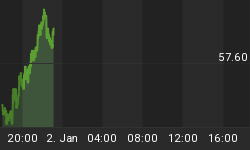In last week's "gift" to investors, the SP500 gained 3.5% making up all of the losses that it had sustained for the month of November. I am sure that more than one investor is wondering: Why ever sell? Such is our markets where investors have been conditioned that they will not experience the pain of deep (any?) losses for any length of time. Oh well. Yet in a curious development and despite the higher prices, investors turned bearish and to an extreme degree. This should provide support or a floor to prices going forward.
How far will prices advance? The rubber band is far from being stretched too tight as there is little consensus amongst the various sentiment indicators. Or to put it in other words, a market that continually bails out investors or fails to clear out the weak hands is prone to failure. The bounce will probably be playable, but to this observer, these are the kinds of patterns that are consistent with market tops.
The "Dumb Money" indicator (see figure 1) looks for extremes in the data from 4 different groups of investors who historically have been wrong on the market: 1) Investors Intelligence; 2) MarketVane; 3) American Association of Individual Investors; and 4) the put call ratio. This indicator is bearish and in extreme territory. Two consecutive weeks of bearish readings will become a bullish signal.
Figure 1. "Dumb Money"/ weekly
Figure 2 is a weekly chart of the SP500 with the InsiderScore "entire market" value in the lower panel. From the InsiderScore weekly report: "Market-wide sentiment has improved, moving from a Slight Sell Bias to Neutral. The change coincides with the triggering of Industry Buy Inflections - our strongest quantitative indicator - within the Russell 2000 and Energy and Financial sectors."
Figure 2. InsiderScore "Entire Market" value/ weekly
Figure 3 is a weekly chart of the SP500. The indicator in the lower panel measures all the assets in the Rydex bullish oriented equity funds divided by the sum of assets in the bullish oriented equity funds plus the assets in the bearish oriented equity funds. When the indicator is green, the value is low and there is fear in the market; this is where market bottoms are forged. When the indicator is red, there is complacency in the market. There are too many bulls and this is when market advances stall. Currently, the value of the indicator is 61.76%. Values less than 50% are associated with market bottoms. Values greater than 58% are associated with market tops. It should be noted that the market topped out in 2011 with this indicator between 70% and 72%.
Figure 3. Rydex Total Bull v. Total Bear/ weekly
TheTechnicalTake offers a FREE e-newsletter: HERE
Visit TheTechnicalTake website: HERE















